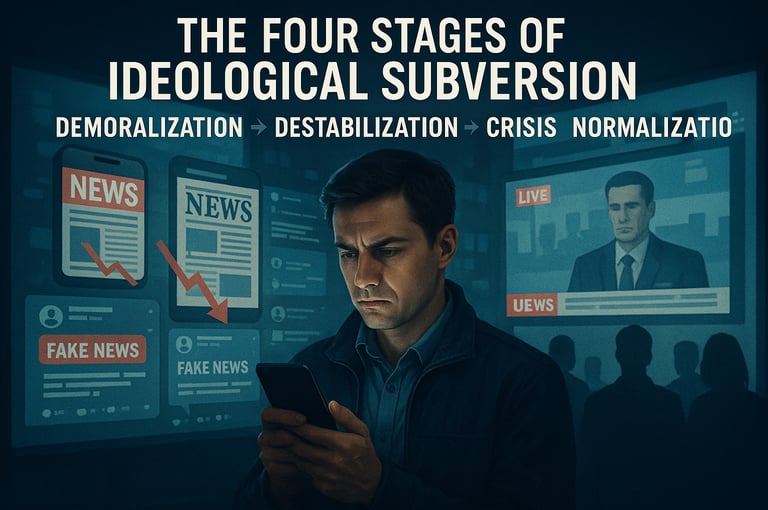The Four Stages of Ideological Subversion
The Four Stages of Ideological Subversion
MYSTERIES & ARCHAEOLOGY
MrTruth.Tv
10/11/20254 min read
The Four Stages of Ideological Subversion
Introduction
Ideological subversion is a term that has been widely discussed within political science, international relations, and propaganda studies. It refers to a strategic process by which a society’s beliefs and values are gradually undermined, leading to cultural and political transformation without direct military confrontation. While the concept entered mainstream discourse during the Cold War—particularly through the insights of former KGB informant Yuri Bezmenov—it remains relevant today in understanding how narratives, media, and education can influence national identity and collective consciousness.
In this article, we will explore the four fundamental stages of ideological subversion: Demoralization, Destabilization, Crisis, and Normalization. We will examine their historical precedents, modern manifestations, and the mechanisms by which they affect societies. Through scholarly references, media analysis, and historical case studies, this article seeks to provide a comprehensive understanding of how ideas, rather than weapons, can redefine nations.
“The simplest way to explain ideological subversion is to change the perception of reality of every American, to such an extent that despite an abundance of information, no one is able to come to sensible conclusions in the interest of defending themselves, their families, their community, and their country.” – Yuri Bezmenov, 1984 interview (Source)
1. Defining Ideological Subversion
A Historical and Academic Perspective
Ideological subversion has roots in ancient history. From the use of propaganda in the Roman Empire to the psychological warfare techniques employed in the 20th century, influencing the hearts and minds of populations has always been a tool of power. Niccolò Machiavelli in The Prince addressed the power of perception, while Sun Tzu in The Art of War emphasized that “the supreme art of war is to subdue the enemy without fighting.”
Modern scholars refer to ideological subversion as a form of “non-kinetic warfare” or “cultural infiltration.” It does not rely on bombs or bullets but on narratives, ideology, and systems of education or mass communication.
According to historian Christopher Andrew in The Sword and the Shield (2000), Soviet intelligence agencies invested heavily in “active measures,” which included disinformation, media manipulation, and academic influence campaigns designed to shape global political discourse.
The Four Stages Framework
Yuri Bezmenov, a Soviet defector and KGB propagandist, famously outlined the four stages of ideological subversion:
Demoralization
Destabilization
Crisis
Normalization
These stages, he argued, could be implemented over decades, ultimately resulting in a population that willingly embraces change antithetical to its foundational values.
2. Stage One: Demoralization
What Is Demoralization?
Demoralization is the longest and most critical phase. It involves eroding the moral and cultural foundations of a nation through prolonged exposure to conflicting ideologies, misinformation, or radical social theories. The goal is to condition a generation to reject traditional values and embrace skepticism toward their heritage, institutions, and national identity.
Methods of Demoralization
Demoralization often begins within the spheres of education, media, and culture. Curriculum shifts, historical revisionism, and the promotion of divisive ideologies can weaken a nation’s core identity. Media outlets—whether knowingly or unknowingly—can amplify polarizing narratives, fostering perpetual outrage.
Historical example: In the late 1960's and 1970's, Western universities saw a rise in ideological movements that questioned foundational societal norms. While intellectual challenge is essential for progress, the infiltration of extremist worldviews—promoting hatred of national identity—contributed to ideological fragmentation.
Psychological Impact
A demoralized society exhibits:
Moral Relativism – the belief that no value system is superior
Loss of Patriotism – skepticism toward national history or symbols
Generational Division – conflict between older traditions and modern ideologies
3. Stage Two: Destabilization
Once demoralization takes root, the next phase is destabilization. This stage focuses on attacking key pillars of society: the economy, defense, and foreign relations. Rather than targeting cultural values, this phase seeks to undermine the functionality of state institutions.
Tools of Destabilization
Economic Turbulence – creating inflation, recession, dependence on foreign powers
Political Polarization – fostering extreme partisan divides
Social Fragmentation – identity politics overpowering national unity
Case Study: The late stages of the Weimar Republic in Germany illustrate destabilization. Before the rise of the Nazi regime, hyperinflation and political gridlock rendered the state nearly dysfunctional, paving the way for radical change.
4. Stage Three: Crisis
Crisis is the tipping point—an eruption caused by accumulated demoralization and destabilization. This may take the form of political revolution, economic collapse, or large-scale civil unrest.
During crisis, populations become desperate for solutions, often willing to trade freedoms for promises of stability.
Examples of Engineered Crisis
Financial Crashes – 1929 Great Depression, 2008 Global Recession
Civil Conflicts – Revolution, mass protests, societal collapse
In this stage, external influencers or ideological actors may introduce a “new order,” claiming to offer salvation while reshaping the country’s political structure.
5. Stage Four: Normalization
Normalization refers to the acceptance of a new ideological or political order, even if it contradicts the nation’s original values. Once crisis resolves, societies enter a stage where previous freedoms may be permanently altered.
Yuri Bezmenov described it bluntly: “Normalization is a cynical expression borrowed from the Soviet Union. When tanks rolled into Czechoslovakia in 1968, Brezhnev said, ‘We have restored normalcy.’”
Characteristics of Normalization
Limited Freedoms Accepted as Security
Historical Erasure – rewriting or censoring the past
Institutional Consolidation – power centralized under new ideology
6. Modern Manifestations of Ideological Subversion
In the digital age, ideological subversion no longer relies solely on pamphlets or broadcasts—it thrives on algorithms, social media, and digital propaganda.
Digital Propaganda Tools
Bot Networks spreading extremist content
Deepfake Technology crafting false narratives
Influence Campaigns targeting elections
According to a 2019 report by the Oxford Internet Institute, over 70 countries used organized social media manipulation operations to influence public opinion (Source).
7. Resisting Ideological Subversion
While ideological subversion is powerful, it is not unstoppable. Key strategies for resistance include:
Education in Critical Thinking
Transparent Media and Fact-Checking
Civic Engagement and National Identity
Callout Quote: “A nation that forgets its past has no future.” – Winston Churchill
Conclusion
The four stages of ideological subversion—Demoralization, Destabilization, Crisis, and Normalization—are not relics of the Cold War. They are living processes, active in the modern world, subtly reshaping societies through narratives rather than warfare.
To preserve freedom, societies must cultivate awareness, historical literacy, and moral courage. For ideological subversion thrives not where force is applied, but where understanding is absent.
Sources & References:
Bezmenov, Yuri. Love Letter to America, 1984.
Andrew, Christopher. The Sword and the Shield, 2000.
Oxford Internet Institute. Global Disinformation Report, 2019.
Sun Tzu. The Art of War.
Machiavelli, Niccolò. The Prince.



